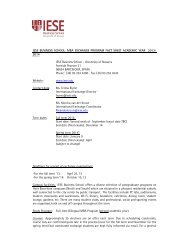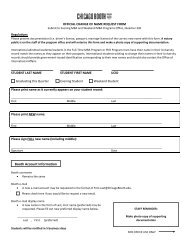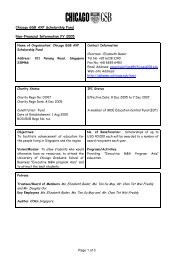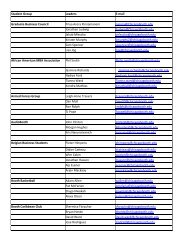Syllabus 42811-88 Strategic Planning Winter, 2009 Marc Knez
Syllabus 42811-88 Strategic Planning Winter, 2009 Marc Knez
Syllabus 42811-88 Strategic Planning Winter, 2009 Marc Knez
Create successful ePaper yourself
Turn your PDF publications into a flip-book with our unique Google optimized e-Paper software.
<strong>Syllabus</strong>Note: This is a preliminary syllabus and subject to change. A revisedsyllabus will be distributed in early August. If you have anyquestions about the course, feel free to e-mail me at the addressbelow.<strong>42811</strong>-<strong>88</strong> <strong>Strategic</strong> <strong>Planning</strong><strong>Winter</strong>, <strong>2009</strong><strong>Marc</strong> <strong>Knez</strong>Contact Information:marc.knez@ChicagoBooth.eduOffice: 773-834-2155Cell: 847-903-6773Course OverviewThis is a shortened version of the strategic planning course taught in the fulltimeMBA program, with a focus on the most fundamental topics covered inthe ten-session course. Consistent with the ten-session course, there are twoprimary themes:1. Strategy Development and AssessmentThe first theme represents the primary focus of the course. Threestrategy development contexts will be covered – business modelinnovation, growth strategy, and long-term strategy. More detail oneach of these three contexts is provided below. In addition to thestrategy development frameworks for each of the above threecontexts, students will learn the fundamentals of how to assess acompany’s current strategy and new strategies under consideration.2. The <strong>Strategic</strong> <strong>Planning</strong> Process: Critical ElementsThere are two (core) components to any properly designed strategicplanning process. First is the development and ongoing revision ofthe annual strategic plan. The annual strategic plan provides explicitdirection and guidelines for the annual budgeting process and
performance management system. Second is the long-term strategicplan that provides direction and guidelines for long-term investmentsdesigned to create new growth opportunities and address long-termthreats to the business. In this short-course, our primary focus will beon the long-term strategic planning component, which relies mostdirectly on effective strategy development and assessment.However, I will provide a basic framework for developing the annualstrategic plan within the broader topic of strategic execution planning.Additional details on the content covered in the course are provided belowwithin the description of the class schedule.MaterialsThe course is taught using lectures, case analysis and readings. There is apacket of readings but no textbook. Supplementary readings will be posted onthe course Chalk site. The most challenging aspect of the course is the amountof reading material covered over five consecutive days. In order to get the mostout of the course, I encourage you to get as much of the reading done prior to thecourse as possible.
ScheduleTuesday 9/8/<strong>2009</strong>Part 1: Basics of Strategy Development & <strong>Strategic</strong> <strong>Planning</strong>Readingsa. From Market Segments to <strong>Strategic</strong> Segments, by Nirmalya Kumarb. Develop the Strategy: The Starting Point for Strategy Execution, byKaplan and Nortonc. The Fall and Rise of <strong>Strategic</strong> <strong>Planning</strong>, by Henry MintzbergPart 2: The Strategy Assessment ProcessOverviewa. Case: Readings for case discussion to be postedPart 1 of Day 1 is focused on the basic elements of business strategy,and the introduction to a strategy assessment framework. Theobjective is to ground you in the fundamental elements of a businessstrategy in order to provide a foundation for engaging in strategyassessment and development. This will be a partial review of topicscovered in the Competitive Strategy course, along with a frameworkfor defining and assessing a business/corporate strategy that will beused throughout the course. The reading From Market Segments to<strong>Strategic</strong> Segments covers several fundamental concepts that will beincorporated into the framework. The last hour of the session will bespent on assessing the strategy of an existing company (case materialto be distributed). [This is classic situational analysis, with a fewadditional dimensions.]Finally, we will also discuss the fundamental elements of the traditionalstrategic planning process. These elements are covered quiteeffectively in the reading: Develop the Strategy: The Starting Point ofStrategy Execution.
Wednesday 9/10/<strong>2009</strong>Strategy Development - Business Model InnovationReadingsa. Case: Zipcar: Refining the Business Modelb. “Note on Business Model Analysis for the Entrepreneur,” byHammermesh et al.c. “Chapter 4: The Business Model.” In Open Innovation: The NewImperative for Creating and Profiting from Technology, byChesbrough, Henry WilliamOverviewThis session will focus on the first of the three strategy developmentcontexts of the course – business model innovation (BMI). We startwith this context because it most directly builds on the fundamentalsof business strategy. BMI entails some significant changes in one, ormore, of the five dimensions of a business model relative to currentaccepted industry practices. 1 [A classic example is Dell’s originaldirect-to-the-customer business model]. While BMI is typically framedin an entrepreneurial context, you will learn its importance in almostall strategy development and assessment contexts.There are two relatively short readings on business models. Thereading - Note on Business Model Analysis for the Entrepreneur, is focusedon the financial portions of the business model, while the second -Chapter 4: The Business Model, provides a more comprehensive framework thatis consistent with the framework used in the class.Finally, the case - Zipcar: Refining the Business Model, provides an excellentexample for both understanding the essential features of BMI andassessing Zipcar’s business model, given its initial performance in themarketplace.1 The five dimensions of a business model consist of the three core elements of a businessstrategy – value proposition, target markets, and critical capabilities, and the two dimensions ofthe profit model – the revenue model and the cost model.
Thursday 9/11/<strong>2009</strong>Strategy Development - Growth Strategy: Extending Beyondthe CoreReadings1. Case: Endeca Technologies: New Growth Strategies, by PaulGompers and Kristen Perry2. Growth Outside the Core, by Zook and Allen3. Strategies of Related Diversification, by Bharat AnandOverviewThis session focuses on the development of strategies that enable acompany to grow by extending their business into adjacent markets.These adjacency expansion strategies come in multiple forms:international markets, new product/service markets, forward/backwardintegration, and new market segments. Each type of expansionstrategy requires unique type of analyses, so it’s beyond the scope ofthe course to provide a complete coverage of this topic. While a broadframework for identifying assessing alternative expansion strategieswill be provided, we will focus on expansion into new customersegmentsThe Endeca Technologies case concerns a company that sellsspecialized search software for the retail industry and is consideringexpansion into the manufacturing industry. It provides a usefulexample of the types of tradeoffs a company faces in this type ofcontext, and will allow us to apply a basic framework for assessingalternative expansion strategies.The Growth Outside the Core reading provides a basic overview of thestrategy expansion topic. The Strategies of Related Diversificationarticle frames the topic of expanding into adjacent markets in thebroader context of related diversification and corporate strategy.Hence, I will also use this session to discuss (briefly) the area ofbusiness portfolio planning at the corporate level.
Friday 9/12/<strong>2009</strong>Long–term <strong>Planning</strong> Part 1 – Trend Analysis and Long-TermGrowth ThemesReadingsa. Case: Medtronic: Vision 2010b. Driving Through the Fog: Managing at the Edge, by George Day andPaul Shoemaker.c. Six Rules for Effective Forecasting, by Paul Saffo,OverviewIn this session, we move to the topic of long-term strategydevelopment. Up to this point we will have examined the impact ofexternal factors (e.g. consumer, competition, technological change,and other macro forces) on strategy development and assessment.When we move to long-term strategy, these external factors arebrought to the forefront of the analysis.The fundamental challenge of long-term strategy development is beingable to identify long-term changes in the market environment, andthen making the appropriate investments to position the company fora competitive advantage as those changes occur. The first step inmeeting this challenge entails the early identification of market trends(broadly defined), and effectively organizing and analyzing thesetrends to provide a basis for developing long-term strategies. Thisprocess is known as horizon scanning, and is described in detail in thearticle: Driving Through the Fog: Managing at the Edge. Also, thearticle Six Rules of Effective Forecasting provides useful insights intohow to incorporate trend analysis into traditional forecasting exercises.Finally, the case Medtronic: Vision 2010 provides an excellent exampleof a company engaging in a comprehensive trend analysis in order toidentify new growth opportunities. Not only will we be able to analyzethe implications of the identified trends on their business, the case willalso allow us to examine how a company conducts long-term planningwithin the formal strategic planning process.
Saturday 9/13/<strong>2009</strong>Part 1: Long–term <strong>Planning</strong> Part 2 – Scenario Analysis forLong-term Strategy DevelopmentReadings1. Scenario <strong>Planning</strong> Case – short readings2. “Three Decades of Scenario <strong>Planning</strong> in Shell” CMR, by Cornelius, Vande Putte, and Romani.3. “Scenario <strong>Planning</strong> for Disruptive Technologies,” 2000, Shoemaker andMavaddatOverviewIn this session, we focus on using scenario analysis for thedevelopment of long-term strategies. As will be made clear whenstrategy assessment is covered earlier in the week, the success of anystrategy (near term, or long-term) depends and the fit between thestrategy and market environment. Hence, when developing long-termstrategies, it’s critical that these strategies are developed with a clearview of alternative future scenarios.The two readings listed above, together, provide a comprehensivedescription of traditional scenario analysis. Note that I will introducethe basics of scenario analysis earlier in the week as part of thestrategy assessment process. Rather than using a Harvard case forthis session, a short set of readings (TBD) will be used to do a short,in-class, scenario analysis.Part 2: Critical Elements of the <strong>Strategic</strong> <strong>Planning</strong> ProcessReadings1. Core Objectives: Clarity in Designing Strategy, by Sayan Chatterjee2. Which Initiatives to Implement, by Alan Brache and Sam Bodley-Scott3. The Office of Strategy Management: Emerging Roles andResponsibilities, by Robert Kaplan and David NortonOverviewThe last portion of this session of the class will focus on the strategicplanning process, and in particular, strategy execution planning.
















